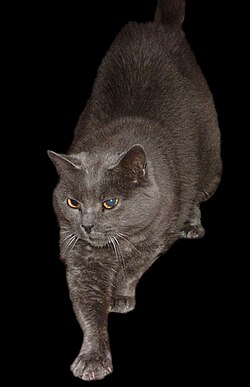Difference between revisions of "AY Honors/Cats - Advanced/Answer Key"
("with" to "provides") |
|||
| Line 1: | Line 1: | ||
| − | [[Image: | + | {| border=1 cellspacing=0 align=right cellpadding=2 |
| − | + | |- align=center bgcolor=pink | |
| + | !Chartreux | ||
| + | |- align=center | ||
| + | |[[Image:Chartreux_Cat_1.jpg|225px|Chartreux cat]] | ||
| + | |- align=center bgcolor=pink | ||
| + | !Country of origin | ||
| + | |- align=center | ||
| + | |[[France]] | ||
| + | |- align=center bgcolor=pink | ||
| + | !Breed standards (external links) | ||
| + | |- align=center | ||
| + | |[http://www.cfainc.org/breeds/standards/chartreux.html CFA], [http://www.acfacat.com/breeds/standards/chartreuxstd.html ACFA], [http://www.cca-afc.com/Chad.html CCA], [http://www.acf.asn.au/Standards/Chartreux.htm ACF],<br> [http://www.tica.org/cxstd03.pdf TICA], FIFe | ||
| + | |} | ||
| − | The | + | The '''Chartreux''' is an internationally-recognized [[cat breed|breed]] of domestic [[cat]]. Chartreux cats are from [[France]], reportedly originally bred by [[Carthusian]] Catholic monks at their monastery in [[Grenoble]] for the purposes of catching [[mice]] to preserve food storages from loss and damage. Legend has it the Chartreux's ancestors were feral mountain cats from what is now [[Syria]], brought back to France by returning [[Crusaders]] in the 13th century. The first documented mention of the breed was by the French naturalist [[Georges-Louis Leclerc, Comte de Buffon|Buffon]] in the 17th century. The first Chartreux were brought to the [[USA]] in 1971. |
| − | + | Physically, the Chartreux is large and muscular with short but powerful limbs, big paws and very fast reflexes. They are known for their blue (grey) double-thickness fur coats and gold- or copper-colored eyes. Chartreux cats are known for their "smile"; due to the structure of their heads and long, tapered muzzle, they often appear to be smiling. | |
| − | + | Chartreux cats tend to be quiet, rarely making noises such as mewing or crying. Some are mute. They are quite observant and intelligent, with some Chartreux learning to operate radio on/off buttons and to open screen door latches. Chartreux cats are also fond of chasing and playing well into their adult years; some can be taught to fetch small objects in the same manner as a dog. Chartreux are good with children and other animals, are nonaggressive and affectionate, good travelers and are generally very healthy. | |
| − | + | Historically famous Chartreux owners include the French novelist [[Colette]] and French general/president [[Charles de Gaulle]]. | |
| + | |||
| + | The Chartreux breed was advanced to championship status in 1987 by the Cat Fancier's Association (CFA.) | ||
== External links == | == External links == | ||
| − | *[http://www. | + | *[http://www.cfainc.org/breeds/profiles/chartreux.html CFA profile] |
| + | *[http://www.chartreux-europe.com Chartreux d'Europe] | ||
| + | *(http://www.chartreux-de-mumm.de) | ||
[[Category:Cat breeds]] | [[Category:Cat breeds]] | ||
| − | [[ | + | |
| + | [[de:Chartreux]] | ||
| + | [[fr:Chartreux (chat)]] | ||
Revision as of 08:42, 31 July 2005
| Chartreux |
|---|

|
| Country of origin |
| France |
| Breed standards (external links) |
| CFA, ACFA, CCA, ACF, TICA, FIFe |
The Chartreux is an internationally-recognized breed of domestic cat. Chartreux cats are from France, reportedly originally bred by Carthusian Catholic monks at their monastery in Grenoble for the purposes of catching mice to preserve food storages from loss and damage. Legend has it the Chartreux's ancestors were feral mountain cats from what is now Syria, brought back to France by returning Crusaders in the 13th century. The first documented mention of the breed was by the French naturalist Buffon in the 17th century. The first Chartreux were brought to the USA in 1971.
Physically, the Chartreux is large and muscular with short but powerful limbs, big paws and very fast reflexes. They are known for their blue (grey) double-thickness fur coats and gold- or copper-colored eyes. Chartreux cats are known for their "smile"; due to the structure of their heads and long, tapered muzzle, they often appear to be smiling.
Chartreux cats tend to be quiet, rarely making noises such as mewing or crying. Some are mute. They are quite observant and intelligent, with some Chartreux learning to operate radio on/off buttons and to open screen door latches. Chartreux cats are also fond of chasing and playing well into their adult years; some can be taught to fetch small objects in the same manner as a dog. Chartreux are good with children and other animals, are nonaggressive and affectionate, good travelers and are generally very healthy.
Historically famous Chartreux owners include the French novelist Colette and French general/president Charles de Gaulle.
The Chartreux breed was advanced to championship status in 1987 by the Cat Fancier's Association (CFA.)
